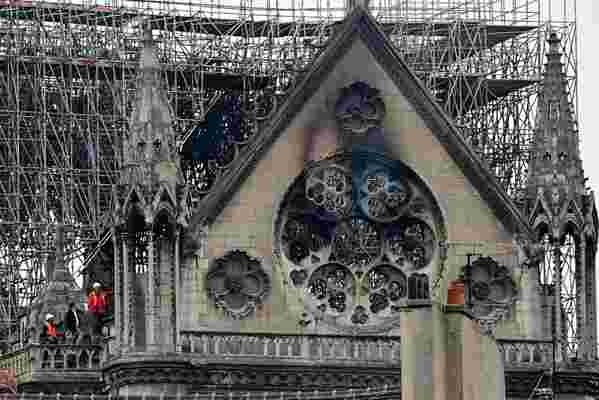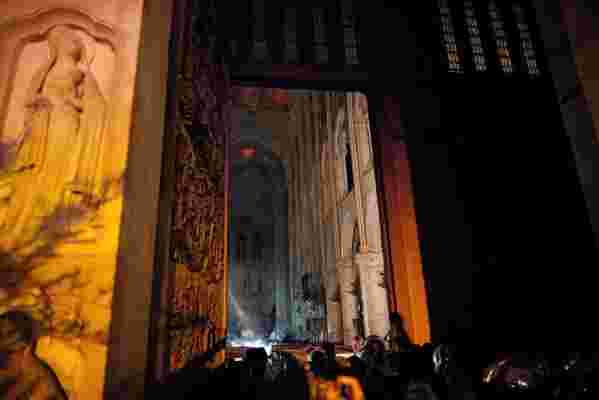Why Removing the Melted Scaffolding From Notre Dame Is the Key to Its Preservation
On April 15, 2019, the world stopped and watched in awe as the roof and central spire of Notre-Dame Cathedral burned and collapsed . Within a week, people around the world had donated more than a billion euros for the architecturally and historically significant cathedral’s restoration. But nine months later, substantial obstacles stand in the way of hitting Emmanuel Macron’s stated goal of reopening in time for the 2024 Olympics. General Jean-Louis Georgelin, the former French chief of the defense staff tasked with overseeing the reconstruction in late November, has admitted to the press that “the cathedral is still in a state of peril.” Similarly, Notre-Dame rector Monsignor Patrick Chauvet said there’s a “50 percent chance” the structure might run into issues that would fundamentally alter the nature of the legendary site. The fire destroyed the spire and roof, which is central to upholding the structure.
So what must be done? At the time of the blaze, the storied church was nearing the end of a $6.8M renovation, and metal scaffolding had been put up to protect the 19th-century spire. The high temperatures generated by the flames engulfed the church’s wooden roof, fusing the scaffolding. As it stands, the most pressing obstacle is removing the warped metal. According to both existing restoration plans and the words of preservation experts who spoke with AD, this is the first major step toward assessing and ultimately undoing the fire’s damage.
“As the roof burned, it exposed the inner vaults that hold the cathedral walls together to outside forces, including some of the fused scaffolding, which fell on their thinnest structural points,” Krupali Uplekar Krusche, associate dean for research at the University of Notre Dame’s School of Architecture and founder of the Digital Historic Architectural Research and Material Analysis Lab, says. “This creates a concern about the structural stability and strength of the vaults.”

A closer look of the spire encased in a cage of scaffolding.
Removing that scaffolding will be as complicated as it is crucial. Multiple levels of steel beams will need to be placed around the scaffolding to provide support and stabilization. Technicians, who will be lowered into the web of tangled scaffolding by telescoping crawler cranes, must carefully coat the pipes to minimize lead pollution from the burned roof before ultimately cutting the obstructions away.
It’s difficult to overstate how essential removing that scaffolding is to protecting the vaults, which are crucial to both the engineering and aesthetics of Notre-Dame. “Collapse of the masonry vaults would be a huge loss, as vaulting is a character-defining feature of the great Gothic churches,” says Frank Matero, professor of architecture and chair of the Graduate Program in Historic Preservation at the University of Pennsylvania’s Stuart Weitzman School of Design. “Vault collapse would destabilize the entire structure and significantly compromise its overall integrity in every way.”

Firefighters prepare to enter the burning cathedral last April.
Ensuring Notre-Dame’s damaged masonry can support the same weight it once did will require careful and deliberate study, Matero says. “The masonry may be compromised in ways not yet determined. Forensic examination of the masonry materials and the structure, namely the walls, vaults, and flying buttresses, will take time.”
The ultimate resource for design industry professionals, brought to you by the editors of Architectural Digest

While a French law requiring the restoration to preserve the “historic, artistic, and architectural interest” of Notre-Dame is already in place, there are other more concrete reasons this process will be informed by the historical realities of the structure. For example, Krusche notes that any weakened limestone from the vaults might need to be swapped out, ideally for stones from the same quarry to maintain a consistency of strength and quality.
Inside, debris gathers on the floor and a hole in the ceiling exposes the church to the elements.
In the short term, sizable—albeit temporary—changes to the look of the space are needed. Sliding roofs will be installed above the nave and the choir of the cathedral to prevent falling objects from further damaging the building. Once the scaffolding is finally removed, a larger temporary roof will cover Notre-Dame as a whole until the restoration work is complete to prevent any further damage to weight-bearing elements of the cathedral.
While there’s much work to be done and many obstacles in the way, there’s still reason to believe that Notre-Dame can be made stronger than ever while preserving its status as both an exemplar of religious architecture and what Matero calls a “particularly important witness to French history.” Krusche points to the 10-year restoration process of Dresden’s Frauenkirche as a potential model. Completed in 2005, the project used both new and original stones to rebuild the church bombed during World War II in accordance with architect George Bähr’s original 18th-century blueprint.
“A solution where some structural steel covers up the regular Notre-Dame roof would help the building get its structural stability back while preserving an outer look that evokes the historical significance we all remember from before the fire,” Krusche says. “We need a symbolic and realistic project that is not done hastily, but with respect for what this cathedral means to all of us.”